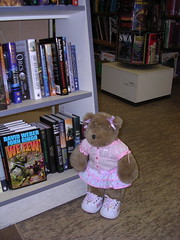Felicia at the Uncles
And she had a great time browsing the shelves.

We bought a lot of books, but the pile that Felicia and I bought will be shipped later, when a could other books arrive. So much for instant gratification.
Just my little corner of the Interweb
And she had a great time browsing the shelves.

We bought a lot of books, but the pile that Felicia and I bought will be shipped later, when a could other books arrive. So much for instant gratification.
Those last four entries of books are ones that I’ve finished between February and now — I’ve been too busy to read much, and way too busy to write up in my diary. Here’s hoping that I’ll have more time to read after the AAS meeting next week…
by Jon Hein
Repeat after me: Not all fun web sites need to be made into books.
This is a book based on the Jump the Shark web site, where people discuss when various TV shows, celebrities and politicians “jumped the shark”. Of course, the phrase “jump the shark” refers to an episode of Happy Days where Fonzie jumped a shark cage on water skis, also widely viewed as the moment when Happy Days showed that it was past its prime.
The problem with the book, though, is that we get only Hein’s opinion on when people jumped. We lose the interaction of the website, which, frankly, is the fun part.
by Greg Bear
I wasn’t going to pick this book up, since I wasn’t very happy with the last part of Darwin’s Radio; however, I found it on the free book-exchange shelf at work, and figured the price was right.
I’m glad I did pick this up. The book picks up 15 years after the Sheva virus first struck. Kaye, Mitch, and Stella (their “virus daughter”) are still on the run. Most of the “virus children” are in special schools (most of which were formerly prisons), and they are approaching puberty, which is making a lot of ignorant politicians nervous.
The book is pretty good — certainly better than the last quarter of Darwin’s Radio, and almost to par with first three-quarters.
by Peter David
Calhoun and the USS Excalibur visit a planet that has been embroiled in civil war for centuries. Calhoun is worhipped as their savior from war, and, of course, things go wrong.
Standard stuff for ST:NF — fun, fast, and quickly forgotten.
Edited by Gardner Dozois
This is a collection of pieces published in Isaac Asimov’s Science Fiction Magazine during the 80s. A few notable stories:
The other stories were good. Overall a decent book, but not one I’d go out of my way to find.
Here are the rules:
Here’s the same thing from home:
“What’s a Pervect doing traveling with a Klahd, anyway?”
“Who’s a clod,” I bristled.
“Easy, kid,” Aahz said soothingly.
From Another Fine Myth by Robert Asprin. Certainly less intelligent that my “Work version”…more fun, too.
Here are the rules:
Here’s mine:
The transformation of components of the second rank ημν transform by
η’αβ = Λαν Λβμ ημν
by comparison with Eq. (4.26), η’αβ = ηαβ. Thus ηαβ has the same components in all frames, as we have assumed.
From Radiative Processes in Astrophysics by George B. Rybicki and Alan P. Lightman. No lie — that’s the book I have out on my desk at work. Maybe I’ll try at home tonight, and see what’s lying around there.
[Link from Mr. Hassle’s Long Underpants]
by Philip Pullman
In this second book of the Sally Lockhart trilogy, where we pick up with Sally a few years after The Ruby in the Smoke. She has built herself a small financial consulting business, no small feat for a woman in 1878, and has helped her friends from the first book build a respectable photography business.
This novel starts with two seemingly unrelated minor mysteries — one involves the sinking of a ship, losing one of Sally’s customers all of her retirement savings that she had put into that ship on Sally’s advice; the other involves an enigmatic performer at the theater where Sally’s friend Jim (and also employee at the photography studio) works backstage. These mysteries come together when an elusive company, North Star, pops into both the mystery of the ship, and the mystery of the marked performer.
Pullman’s style is easy and fun to read; though I tend to get lost during fight scenes, so I just skim ahead and see who’s standing at the end. I like that he doesn’t treat any of his characters as sacred, though I was a bit startled and upset by a death near the end of the novel.
I look forward to finding and reading the last book in the series.
This is an excellent collection of short stories based on classic fairy tales. I enjoyed virtually all of the stories (with the exception of “The Frog King, or Iron Henry”), most notably:
There are more collections like this from the same editors, and a series of novels based on fairy tales, all of which I’m looking forward to delving into them.
Copyright © 2025 My Silly Life All rights reserved. Theme by Laptop Geek.